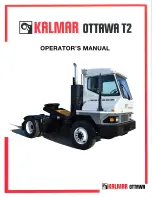
03
.1
1
E
N
52
4.3
Lifting, transporting and depositing loads
WARNING!
Unsecured and incorrectly positioned loads can cause accidents
Before lifting a load unit the driver must make sure that it has been correctly palletised
and does not exceed the truck’s capacity.
X
Instruct other people to move out of the hazardous area of the truck. Stop working
with the truck if people do not leave the hazardous area.
X
Only carry loads that have been correctly secured and positioned. Use suitable
precautions to prevent parts of the load from tipping or falling down.
X
Damaged loads must not be transported.
X
Never exceed the maximum loads specified in the capacity chart.
X
Never stand underneath a raised load handler.
X
Do not stand on the load handler.
X
Do not lift other people on the load handler.
X
Insert the forks as far as possible underneath the load.
NOTE
With the two-stage Duplex mast (ZZ) the short, centre-mounted free lift cylinder
initially lifts the load carriage (free lift) without changing the overall height of the truck.
NOTE
Adapt a slower speed when stacking and retrieving.
4.3.1 Lifting load units
Requirements
– Load unit correctly palletised.
– Load unit weight matches the truck's
capacity.
– Forks evenly loaded for heavy loads.
Procedure
• Drive the truck carefully up to the pallet.
• Slowly insert the forks into the pallet until the
fork shank touches the pallet.
Z
The load unit must not extend by more than
50 mm beyond the fork tips.
• Press the “Lift” button (49) button until you reach the desired lift height.
The load unit is raised.
Z
The lift/lower speed can be infinitely controlled through the movement of the button.
Short stroke = slow lift / lower
49
48
03
.1
1
E
N
52
4.3
Lifting, transporting and depositing loads
WARNING!
Unsecured and incorrectly positioned loads can cause accidents
Before lifting a load unit the driver must make sure that it has been correctly palletised
and does not exceed the truck’s capacity.
X
Instruct other people to move out of the hazardous area of the truck. Stop working
with the truck if people do not leave the hazardous area.
X
Only carry loads that have been correctly secured and positioned. Use suitable
precautions to prevent parts of the load from tipping or falling down.
X
Damaged loads must not be transported.
X
Never exceed the maximum loads specified in the capacity chart.
X
Never stand underneath a raised load handler.
X
Do not stand on the load handler.
X
Do not lift other people on the load handler.
X
Insert the forks as far as possible underneath the load.
NOTE
With the two-stage Duplex mast (ZZ) the short, centre-mounted free lift cylinder
initially lifts the load carriage (free lift) without changing the overall height of the truck.
NOTE
Adapt a slower speed when stacking and retrieving.
4.3.1 Lifting load units
Requirements
– Load unit correctly palletised.
– Load unit weight matches the truck's
capacity.
– Forks evenly loaded for heavy loads.
Procedure
• Drive the truck carefully up to the pallet.
• Slowly insert the forks into the pallet until the
fork shank touches the pallet.
Z
The load unit must not extend by more than
50 mm beyond the fork tips.
• Press the “Lift” button (49) button until you reach the desired lift height.
The load unit is raised.
Z
The lift/lower speed can be infinitely controlled through the movement of the button.
Short stroke = slow lift / lower
49
48
Summary of Contents for EJC B14
Page 1: ...09 05 03 11 50470432 EJC B14 B16 Operating instructions G EJC B16 EJC B14...
Page 3: ...03 11 EN 4...
Page 9: ...0506 GB 2...
Page 17: ...03 11 EN 16 3 2 Dimensions h4 h3 h1 l2 l1 l c y Q h s h8 b5 Ast W a B m2 20 5 h2 b4...
Page 25: ...03 11 EN 24...
Page 29: ...03 11 EN 28...
Page 37: ...03 11 EN 36...
Page 39: ...03 11 EN 38 2 Displays and Controls 7 9 10 12 8 14 50 47 48 49 3 5 3 2...
Page 86: ...85 03 11 EN Spay all exposed electrical contacts with a suitable contact spray...
Page 107: ...0506 GB 18...






































